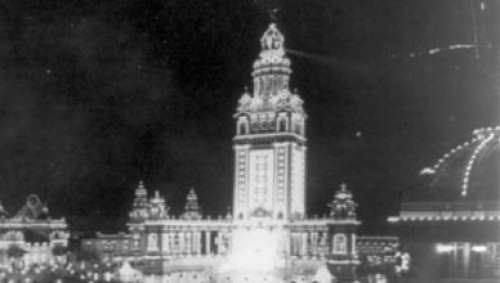

 The Life of Theodore Roosevelt
The Life of Theodore Roosevelt
 The History of the House
The History of the House
 The Inauguration
The Inauguration
 The Pan-American Exposition
The Pan-American Exposition
 Contemporary Historical Figures
Contemporary Historical Figures

From May 1 to November 2,1901, Buffalo, N.Y. hosted the Pan-American Exposition, which highlighted the cultures and achievements of Western Hemisphere nations. Taking place not long after the Spanish-American War, the Exposition was also a reaffirmation of the friendship and mutual interests shared by the countries of North, South, and Central America. It was also a great opportunity to showcase exciting new technology.
In 1901, Buffalo, New York was located within a five hundred-mile radius of the most populated cities in North America. Coupled with an extensive transportation network of ships and rails, located near a world famous natural wonder and at the doorstep of Canada, Buffalo was chosen to host a world’s fair. This event, called the Pan-American Exposition, took place in the northern part of the city from May to November. The “Pan-Am” highlighted the cultures and developing technologies from nations of the Western Hemisphere. Taking place not long after the Spanish-American War (1898), the Exposition was also a re-affirmation of the friendship and mutual interests shared by the countries of North, South and Central America. Dozens of temporary buildings, made from wood and plaster, were constructed in the year and a half before the Exposition opened. Painted according to an intricate color scheme, the buildings were brightly-colored and inspired the nickname “Rainbow City.” Their ornate features blended classical architecture with Spanish influences from Latin America. Inside, visitors enjoyed cultural, artistic and technological exhibits. There were also midway attractions, sporting events and concerts.
Each evening, hundreds of thousands of eight-watt light bulbs were gradually illuminated and outlined the buildings, reflecting pools, fountains and sculptures that occupied the grounds. This was the first massive display of electric power to take place in the United States and it utilized electricity generated by the power plants at Niagara Falls, New York—twenty miles away. In the eyes of people accustomed to gas, oil, and candlelight, the effect was both beautiful and startling. Thomas Edison even recorded it with one of his early moving picture cameras.
Despite much anticipation and publicity, the “Pan-Am” did not reach its expected attendance goal. Cool, rainy weather in the spring and summer kept people away. By the time the weather improved in September, the Exposition was then overshadowed by the assassination of President McKinley. When it closed on November 1, only eight million people of the projected twenty million had actually visited the Exposition.
Within a year, most evidence of the Exposition had disappeared. The tract of land it occupied soon gave way to residential and commercial property. The New York State Building, one of the few permanent structures built for the Exposition, is now The Buffalo History Museum. A few buildings and parts of buildings remain scattered throughout the area and “Pan-Am” souvenirs are now much sought after memorabilia.
Aside from the McKinley assassination, the “Pan-Am” had some positive effects on the city of Buffalo. Millions of visitors were drawn to this center of commerce, industry and transportation. Many decided to make Buffalo their permanent home. Industrialists and entrepreneurs saw the potential of electricity and the area’s transportation network. New industries, including steel and automobile manufacturing, came to Buffalo or expanded here because of the virtues of the area extolled at the Exposition.

The Theodore Roosevelt Inaugural National Historic Site is operated by the Theodore Roosevelt Inaugural Site Foundation, a registered non-profit organization, through a cooperative agreement with the National Park Service.
© 2025 | All Rights Reserved
641 Delaware Avenue, Buffalo, NY 14202 • (716) 884-0095
Website by Luminus
